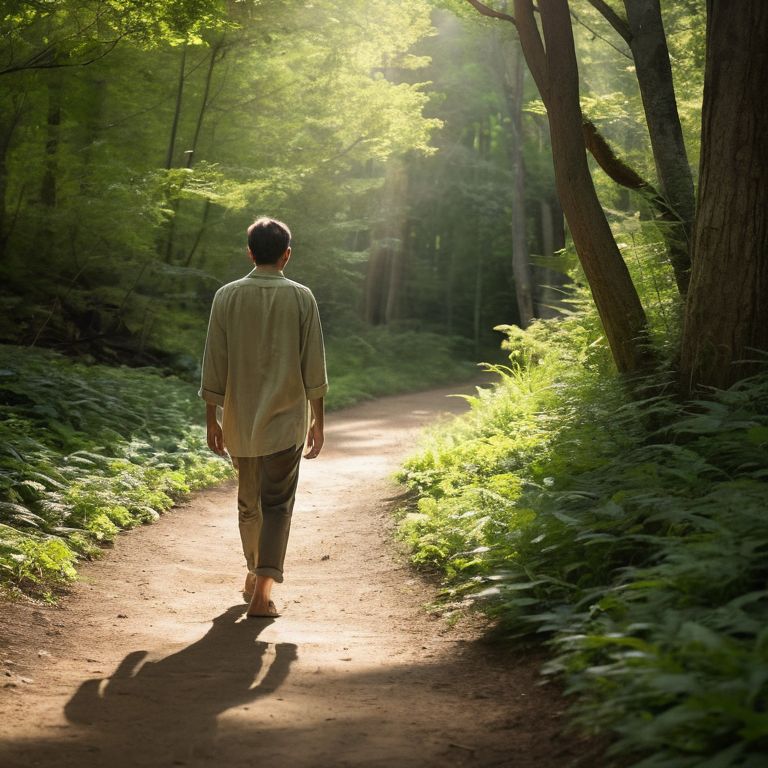Take a deep breath in, and as you exhale, allow your gaze to softly focus on the present moment. I still remember my first experience with how to practice walking meditation outdoors; it was in a serene monastery garden, where the gentle rustle of leaves and the warmth of the sun on my skin taught me that mindfulness isn’t about achieving a specific state, but about embracing the simplicity of each step. As I walked, I realized that the common belief that walking meditation requires a specific environment or a certain level of mental discipline is a myth. In reality, all you need is a willingness to listen to your breath and the earth beneath your feet.
As we explore how to practice walking meditation outdoors together, I promise to share with you practical, honest advice that has helped me and many of my students find peace in the simplest of actions. You’ll learn how to transform your daily walks into opportunities for mindfulness, letting go of distractions and grounding yourself in the present. We’ll take it one step at a time, and by the end of this guide, you’ll be equipped with the tools to turn any walk into a meditative journey, no matter where you are or what’s happening around you.
Table of Contents
Guide Overview: What You'll Need

Total Time: 30 minutes to 1 hour
Estimated Cost: Free – $0
Difficulty Level: Easy
Tools Required
- Comfortable Walking Shoes with good traction
Supplies & Materials
- Quiet Outdoor Space such as a park or nature trail with minimal distractions, approximately 10 feet by 10 feet or larger in size, with a smooth and even surface, free from obstacles and tripping hazards
Step-by-Step Instructions
- 1. To begin, find a quiet spot outside where you can walk without distractions, and take a moment to notice the sensation of your feet touching the ground. This is the foundation of our walking meditation, and it’s essential to feel the earth beneath you. Allow your eyes to gently focus on a point ahead, without staring intensely, and start by taking a few deep breaths to calm your mind.
- 2. Next, bring your attention to your breath, feeling the sensation of the air moving in and out of your body. As you inhale, imagine fresh energy entering your system, and as you exhale, imagine any tension or stress leaving your body. Take a slow, deliberate step forward with one foot, keeping your knees slightly bent to maintain balance, and focus on the sensation of your foot lifting, moving, and then touching the ground again. This is the start of our mindful walking practice, where we pay attention to every step.
- 3. Now, let’s establish a rhythm for our walking meditation. Take another step with the other foot, and as you do, focus on the sensation of your foot touching the ground. Try to release any thoughts or distractions, and simply be present with the sensation of walking. Remember, the goal is not to reach a destination, but to be fully engaged in the process of each step. Bring your attention back to your breath whenever your mind wanders, and allow yourself to settle into the calmness of the present moment.
- 4. As you continue walking, pay attention to the movement of your legs, hips, and arms. Allow your arms to swing freely, and your hips to sway gently, keeping your posture relaxed and open. With each step, imagine you’re leaving behind any worries or concerns, and embracing the serenity of the present. Take your time, and don’t rush – the slower you walk, the more opportunity you’ll have to cultivate mindfulness.
- 5. To deepen your practice, bring your attention to the sensations in your body. Notice the feeling of the sun on your skin, the wind in your hair, or the sound of birds chirping around you. Allow these sensations to become a part of your walking meditation, and imagine that with each step, you’re becoming more grounded and connected to the natural world. Remember to breathe naturally, and don’t try to control your breath – simply allow it to be a gentle guide for your practice.
- 6. As you walk, you may encounter obstacles or challenges, such as uneven terrain or distracting noises. Instead of trying to avoid or resist them, try to approach them with curiosity and kindness. Imagine that each obstacle is an opportunity to practice mindful acceptance, and that by acknowledging and accepting it, you can find a sense of peace and calm in the midst of chaos. Take a deep breath, and allow yourself to flow around the obstacle, like water flowing around a rock.
- 7. Finally, as you come to the end of your walking meditation, take a moment to pause and reflect on your experience. Notice how you feel, and what sensations are present in your body. Allow yourself to savor the calmness that has arisen, and imagine that you can carry this sense of peace with you throughout your day. Take a few deep breaths, and when you’re ready, slowly open your eyes, feeling refreshed, renewed, and more connected to yourself and the world around you.
Finding Peace in Outdoor Steps

As we explore the world of mindful walking, let’s take a moment to appreciate the serenity of nature. Outdoor meditation spaces offer a unique opportunity to connect with the earth and calm our minds. By incorporating sensory awareness exercises into our walking meditation practice, we can deepen our experience and find greater peace.
When we walk, our minds often wander, but with mindful walking techniques, we can learn to gently bring our focus back to the present moment. Nature based mindfulness encourages us to slow down and notice the sights, sounds, and smells around us. This can be a powerful tool for walking meditation for stress relief, allowing us to release tension and find calm in the midst of chaos.
As we cultivate this practice, we may begin to notice the benefits of mindful walking in our daily lives. Our steps become more deliberate, our minds more clear. We can apply meditation pacing strategies to our walks, using the rhythm of our footsteps to guide us into a state of greater awareness. By doing so, we can transform our daily walks into opportunities for growth, reflection, and peace.
Benefits of Nature Based Mindfulness
As we walk, the natural world awakens our senses, calming the mind. With each step, the rhythm of our breath synchronizes with the rustling of leaves or the gentle breeze. This harmony allows us to let go of distractions, embracing the present moment. The earthy scent and vibrant colors of nature envelop us, quieting the mind and nurturing our spirit.
In this serene environment, we begin to notice the subtle interconnectedness of all things. The trees, the flowers, and even the sky above us become reflections of our own inner landscape. As we cultivate mindfulness in nature, we reap the rewards of reduced stress, increased clarity, and a deeper sense of connection to ourselves and the world around us.
Mindful Walking Techniques Unveiled
As we walk, let’s unveil the mindful techniques that will deepen our connection to the present. Notice the sensation of your feet touching the ground, the gentle pressure with each step. Allow your gaze to fall softly on the path ahead, taking in the sights and sounds without judgment. With each breath, feel the rhythm of your footsteps, the rise and fall of your chest, and the sensation of the air on your skin.
In this mindful state, we begin to let go of distractions and simply be with each step. Our walking becomes a meditation, a celebration of the beauty in everyday moments. As we breathe in, we invite the world to enter our awareness; as we breathe out, we release any tension or thoughts, allowing our feet to guide us home to the present.
Stepping into Serenity: 5 Essential Tips for Outdoor Walking Meditation
- Begin by finding a quiet and peaceful outdoor spot, where the beauty of nature can gently guide your footsteps
- Pay attention to the sensation of your feet touching the ground, feeling the weight and texture of each step
- Bring your awareness to the rhythm of your breath, using it as an anchor to the present moment with each stride
- Notice the sights, sounds, and smells around you, allowing them to enrich your experience without distracting you from your inner calm
- Remember to walk slowly and intentionally, surrendering any need to rush or achieve, and simply be present with each step, in each moment
Embracing Serenity: 3 Key Takeaways
Let the rhythm of your footsteps on the earth guide you into a state of mindfulness, where each step is a reminder to gently bring your mind back to the present
By embracing nature-based mindfulness, you can deepen your connection with the world around you and find peace in the simplest of things, like the sound of leaves crunching beneath your feet
Remember, the practice of walking meditation is not about the destination, but about the journey itself – the journey of cultivating awareness, patience, and kindness with each deliberate step you take
Embracing the Path
As we walk, may our feet kiss the earth with intention, and may our breath be the gentle breeze that brings us back to the serenity of the present moment.
Elara Keane
Embracing the Serenity of Outdoor Walking Meditation

As we conclude our journey through the practice of walking meditation outdoors, let’s take a moment to breathe in the key takeaways. We’ve explored the simple yet profound steps to bring mindfulness into our daily walks, and delved into the benefits of nature-based mindfulness. By incorporating mindful walking techniques into our routine, we can cultivate a sense of inner peace and balance, even in the midst of chaos. Remember, the goal is not to achieve a specific state, but to gently return to the present with each step.
As you embark on your own walking meditation journey, I invite you to embrace the beauty of impermanence. With each step, allow yourself to let go of distractions and simply be. Feel the earth beneath your feet, the sun on your skin, and the rhythm of your breath. In these moments, may you find a deep sense of connection to the world around you, and may your heart be filled with serenity and peace.
Frequently Asked Questions
How can I incorporate walking meditation into my daily routine, even on busy days?
Take one mindful step at a time. Begin with brief walks, even just to the mailbox or around the block, and bring awareness to each step, the sensation of your feet touching the ground, and the rhythm of your breath. As you walk, gently acknowledge each thought, and let it pass, returning to the simplicity of your footsteps.
What if my outdoor space is limited, such as living in a city with little greenery, can I still practice walking meditation effectively?
Take a deep breath in, and out. Even in a city, you can find pockets of calm. Look for a quiet alley, a rooftop, or a small park. Bring your attention to the sensation of your feet touching the ground, and let the rhythm of your steps guide you. Every pace, a chance to breathe, to be present.
Are there any specific physical postures or techniques I should be aware of while practicing walking meditation to get the most out of the experience?
Let’s explore the physical aspects of walking meditation. Keep your posture relaxed, with a gentle engagement of your core. Allow your arms to swing freely, and let your gaze fall softly on the ground about 10 feet ahead. With each step, feel the weight transfer from one foot to the other, anchoring you in the present moment.
